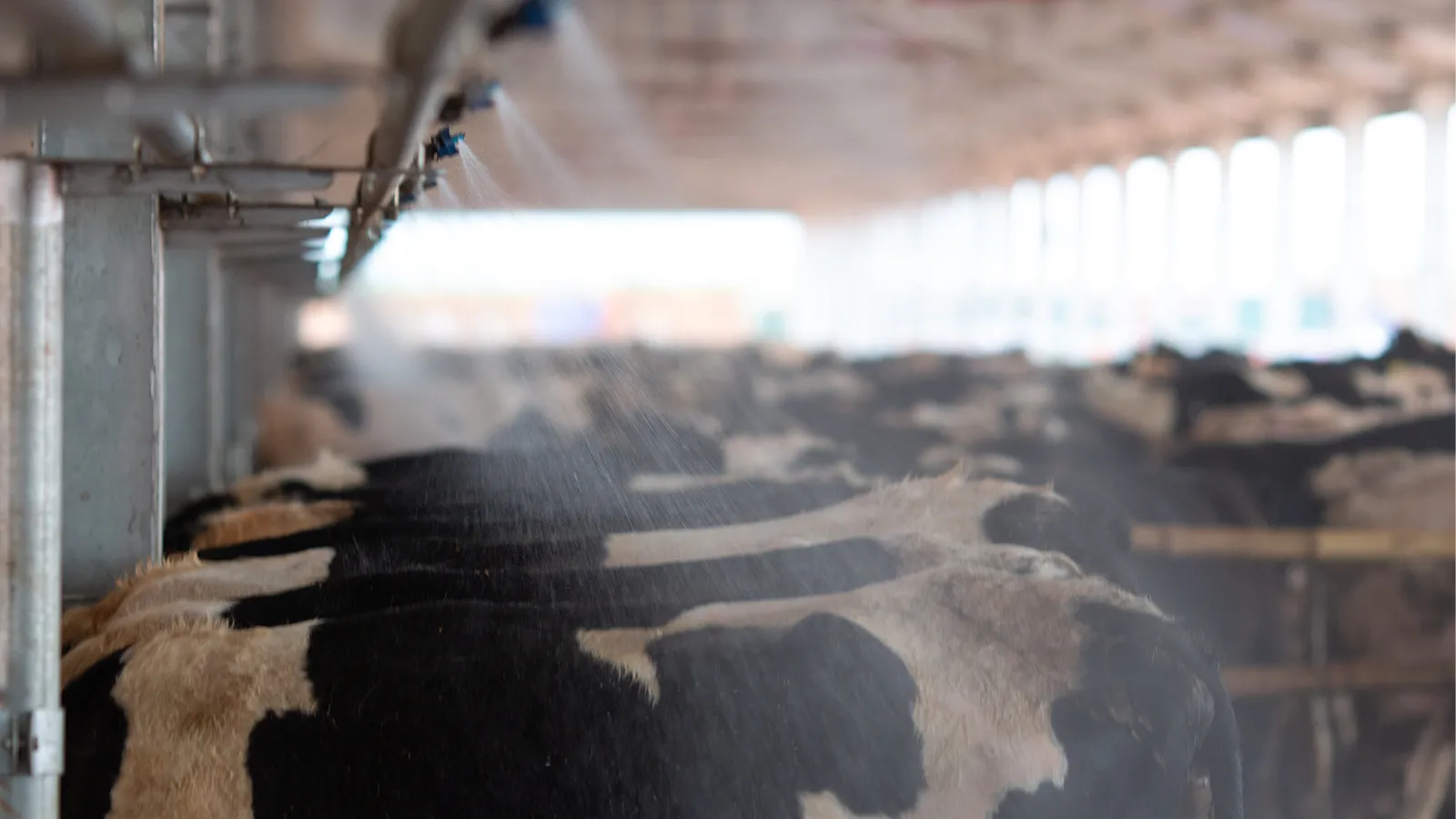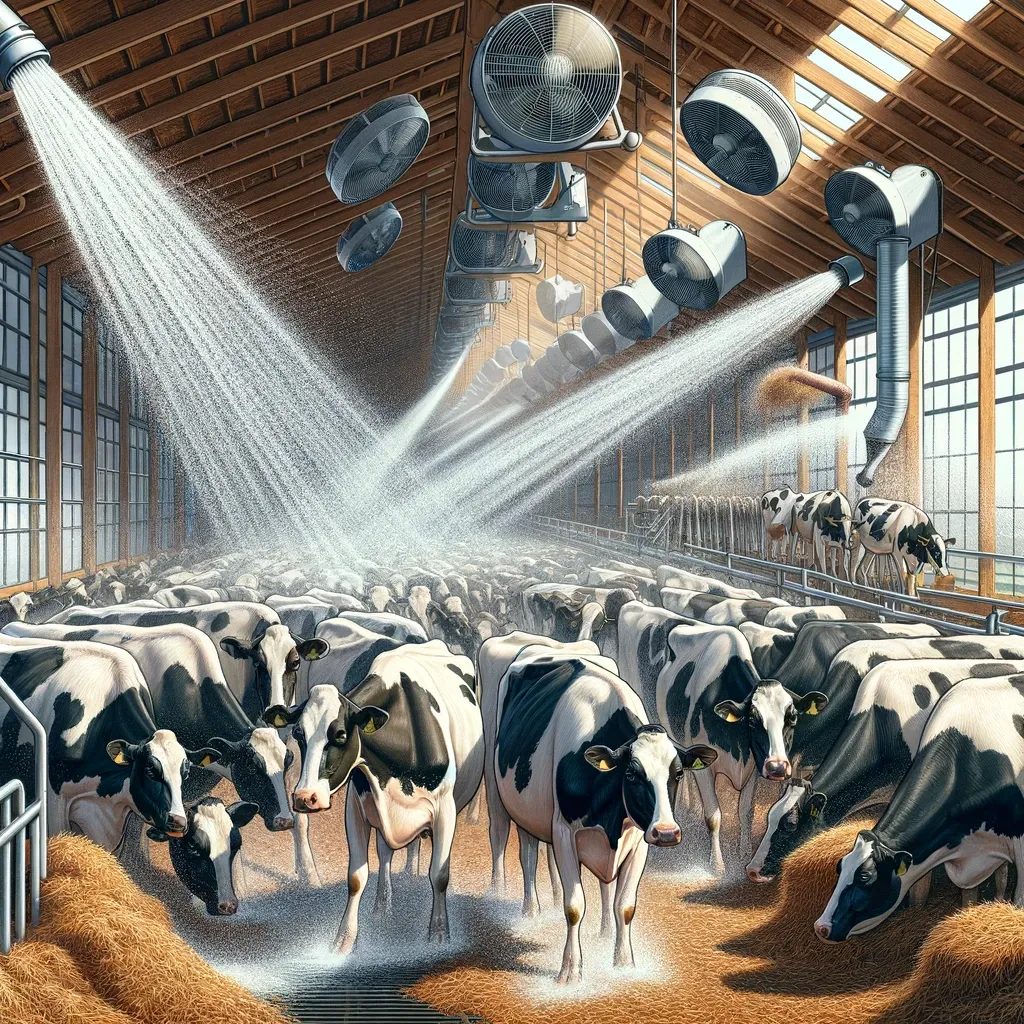Cooling Systems for Dairy Cows to Alleviate Heat Stress
Heat stress in dairy cattle can lead to significant economic losses. Past research has focused on the economic impact of heat stress and the costs associated with cooling systems. Heat stress not only causes milk production losses but also increases the risk of mastitis, reproductive issues, and mortality. It also leads to variable treatment costs, breeding expenses, reduced milk quality, and increased labor. Various options are available to mitigate the effects of heat stress, including shade, ventilation, and adequate water supply. Among the cooling systems, those utilizing showers and fans are preferred, but proper installation is crucial. This article aims to provide information on the installation of cooling systems using showers and fans for dairy farmers planning to combat heat stress.

Heat Stress in Dairy Farming
McDowell defines the optimum environmental conditions for dairy cows as a temperature of 13-18°C, relative humidity of 60-70%, wind speed of 5-8 km/h, and moderate solar radiation. Dairy cows can tolerate varying environmental conditions within certain limits, but when climatic elements shift towards more extreme conditions, it results in increasing stress on the cattle.
Factors such as breed, age, condition, and productivity level of the animal play significant roles in susceptibility to adverse conditions, along with individual differences. Under stressful conditions, dairy cows' performance decreases, negatively affecting the economics of the operation. Research shows that dairy cows in tropical and subtropical climates are adversely affected by heat stress. Harris (1992) reported that a decrease in milk yield due to heat stress begins when the daily average environmental temperature reaches 24°C. Chase et al. (1988) suggested that measures to combat heat stress, such as showers and fans, should be implemented when the ambient temperature exceeds 38°C and relative humidity is at 20%. Keown and Grant (1997) noted that at temperatures above 25-26°C, cows' feed consumption decreases, resulting in reduced milk yield. When the air temperature surpasses 32°C, a 3-20% decrease in milk yield is observed.
Begin Your Journey for Free!
Discover the Full Potential of MilkingCloud for Free!
Enjoy all features with a free plan, tailored for your herd size. Get Started Today!
Mitigating Heat Stress
Various studies have shown that mitigating heat stress can improve dairy cow performance. Measures such as providing shade, ventilation, and ample water supply have been effective in reducing heat stress. In particular, evaporative cooling systems that utilize showers and fans are commonly preferred. However, proper system installation is crucial for their effectiveness.
Managing Heat Stress in the Dairy Herd
Identifying whether the herd is under stress can be accomplished through a simple test. By measuring the rectal temperatures of ten randomly selected cows, it can be determined if they are likely experiencing stress. If seven or more of these cows have rectal temperatures above 39.4°C, it indicates possible stress. This value tends to be higher during afternoon hours when the ambient temperature increases. If rectal temperatures exceed 40°C, cows are likely experiencing severe stress. An increase in respiratory rate is a good indicator, with a knowledgeable observer needed to detect it accurately. If an informed person counts the cows' breaths per minute and finds it to be 80 or more, there is likely stress. If this count exceeds 100, severe stress is evident, and immediate action should be taken.

Cooling System Components and Working Hours
Effective management of dairy farm conditions requires continuous measurement of various variables such as solar radiation, temperature, wind speed, rain, and relative humidity both inside and outside the barn. These measurements are essential for optimizing the dairy cows' environment and well-being.
Cooling System Essentials
To implement a cooling system successfully, certain requirements must be met:
1. Ensure a daily water supply of 100 liters per cow.
2. Provide shade in areas where cows are to be cooled.
3. Establish a system to collect and drain excess water.
4. Ensure access to electricity.
5. Arrange feeding areas close to the cooling zone.
Installation and Operation of Shower and Fan Cooling System
Proper installation and operation of a shower and fan cooling system are essential for effective heat stress reduction. Here are some key principles:
1. Showers should be adjusted to create droplets that wet the cow's skin without causing excess water to drip.
2. After showering, fans should be used to remove the moisture from around the cow using air circulation. Fans can be kept on continuously when ambient temperatures are above the threshold, typically around 24°C.
3. In hot and humid regions, a combination of showers and fans is more effective than using either method alone.
4. Implement automated timers and thermostats to regulate the cooling system based on environmental conditions, optimizing its performance.
5. Properly select and position cooling system components, including shower nozzles and fans, to ensure uniform coverage and airflow.
Fan Types
Various types of fans can be used in cooling systems:
1. Tube fans
These fans provide 150-250 cubic feet per minute (cfm) of air per cow and are suitable for general use.
2. Ceiling fans
Ceiling fans can also be used for air circulation, but they require cows to be directly underneath them to be effective and may not provide uniform cooling.
3. Box fans
These are often mounted on walls and can provide targeted cooling if properly positioned.
Conclusion
Heat stress in dairy cows is a significant concern for farmers due to its economic impact on milk production, cow health, and overall farm profitability. Cooling systems using showers and fans have been proven effective in alleviating heat stress, but proper installation and operation are critical to their success. Dairy farmers should monitor environmental conditions and cow behavior to determine when to activate cooling systems and ensure cows have access to shade, water, and feeding areas. Managing heat stress through effective cooling systems not only benefits the welfare of dairy cows but also contributes to higher milk production and overall farm sustainability.


